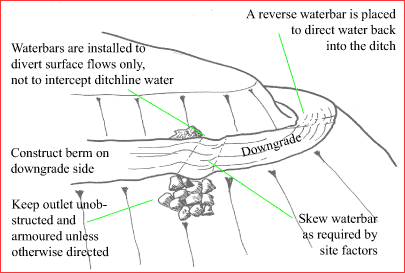| Forest Road Deactivation Practices | |
| in the Pacific Northwest | |
| 3 - Waterbars & Ditchblocks | Descriptions, Active/Inactive Roads |
A waterbar is a wide, shallow ditch excavated across a road to divert road surface runoff off the road to the fillslope, or across the road to the ditchline (reverse waterbar). Waterbars do not intercept ditchlines. Skew the waterbar 20° to 30° depending on site factors such as road grade, anticipated flows and outfall stability. Construct a berm on the downgrade side of the waterbar without impeding vehicle traffic. In erodible materials, armour the waterbar base and outlet to provide erosion protection. Never construct waterbars where they might divert flows onto unstable slopes or unprotected erodible materials or fills.
Figure 1: Waterbar
All ditch blocks must be water tight and constructed from erosion-resistant material (preferably containing coarse, angular rock). The height of the ditch block is determined by the road use as follows:
|
- active roads: with drainage structures in place, the ditch block must be at least as high as the top of the culvert, but at least 15 cm below the road surface. This is a precaution in case the culvert is damaged or cannot handle extreme peak flows. The ditch block below the top of the road surface will allow water to run down the ditch instead of forcing ditch flows onto the road, causing surface erosion. - deactivated roads: culverts are typically removed; if deactivation is not permanent and road access is required at some point in the future, it may be acceptable to leave culverts in place and install backup cross-ditches on the downgrade side of the culvert. Well-constructed ditch blocks ensure that water flows are directed into the cross-ditch and not allowed to run down the ditch. Therefore, contrary to ditchblocks on active roads, ditchblocks on deactivated roads must be higher than the road surface. |
Be sure that deactivation measures are consistent with the road use identified in the access management plan for the operation.
| 3 - Waterbars & Ditchblocks |
| Next |
||
|
Waterbars & Ditchblocks 3
|
|
|
©1999 - 2002 Flip Productions Limited Used with permission by CulvertBC |